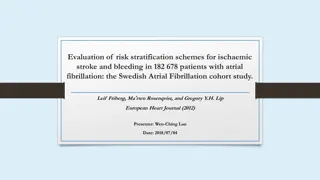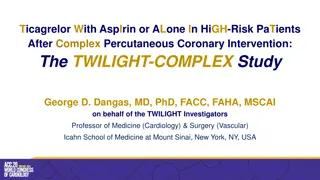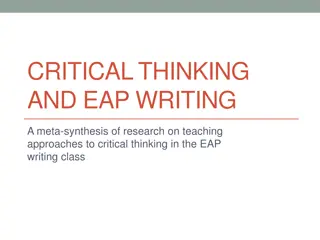fibroids-and-fertility-what-you-need-to-know-
Worried about fibroids impacting your baby\u2019s dreams? Millions of women face the challenging reality of uterine fibroids. Female factor infertility can occur due to many reasons. It is highly important to regularly observe one\u2019s reproductive health. Many women of young age have issues relat
1 views • 6 slides
Understanding Critical and Non-Critical Incidents in Incident Reporting
Critical incidents, as defined by regulations, are serious events that pose immediate risk to health, safety, or welfare. Non-critical incidents, on the other hand, are minor in nature and do not have serious consequences. Incident reports play a crucial role in documenting occurrences, identifying
0 views • 29 slides
Ticagrelor Monotherapy vs. 12-Month Dual Anti-Platelet Therapy After Coronary Stent Implantation for ACS
The study compares the efficacy of ticagrelor monotherapy after less than 1 month of dual anti-platelet therapy (DAPT) to 12-month ticagrelor-based DAPT in patients with acute coronary syndrome (ACS) undergoing percutaneous coronary intervention (PCI) with drug-eluting stent implantation. The aim is
1 views • 19 slides
Risks and Strategies for Safe Caesarean Deliveries in South Africa
Understanding the mortality burden related to caesarean deliveries (CD) in South Africa, this report highlights the need for safe CD practices amidst high maternal death rates. Factors influencing safe CD, checklists for accreditation, and strategies for action plans are discussed. The Case Fatality
0 views • 40 slides
Understanding Bleeding Time and Coagulation Time Tests
The Bleeding Time (BT) test evaluates platelet plug formation and capillary integrity, crucial for surgery preparations. Prolonged bleeding times indicate low platelet count or dysfunction. The Duke method is one way to determine Bleeding Time. Sources of error, such as medication interference, impr
5 views • 8 slides
Understanding Patient Blood Management and Guidelines
Patient Blood Management focuses on optimizing a patient's own blood to avoid unnecessary transfusions through three pillars: optimizing tolerance of anemia, blood volume, and minimizing blood loss. Guidelines and recommendations are developed based on systematic reviews of evidence to improve clini
6 views • 18 slides
Understanding Heavy Menstrual Bleeding: A Comprehensive Overview
A detailed exploration of heavy menstrual bleeding (HMB) by Consultant Gynaecologist Mary Connor, highlighting its impact on women's health and well-being. The importance of early investigations, treatments, and referrals, as well as key considerations for women with obesity or estrogen imbalances.
4 views • 34 slides
How to do Critical Analysis
Massey University provides valuable insights on critical analysis, distinguishing between description and analysis, evaluating evidence and reasons, and making strong arguments. Critical thinking involves evaluating evidence to reach informed conclusions, surpassing mere understanding. While descrip
0 views • 22 slides
Understanding Critical Incident Stress Management (CISM)
Critical Incident Stress Management (CISM) is crucial for addressing the emotional, physical, and psychological reactions to overwhelming events. This includes definitions of critical incidents, CISM teams, peer support, and crisis response teams. Learn how the International Critical Incident Stress
2 views • 25 slides
Understanding Blood Groups, Clotting Time, and Bleeding Time in Medical Practice
This informative material delves into the significance of determining blood groups, clotting time, and bleeding time in medical settings. From explaining the ABO and Rhesus systems to outlining the practical objectives and procedures for the assessments, this resource aims to enhance understanding o
0 views • 34 slides
Understanding Critical to Customer (CTC) and Critical to Quality (CTQ)
Quality is determined by meeting customer needs. Critical to Customer (CTC) Flowdown translates these needs into Critical to Quality (CTQ) aspects. This tool helps organizations identify what is critical to meet customer expectations, serving as a communication tool and guiding improvement projects.
2 views • 10 slides
First Aid Basics and Emergency Response Guidelines
Learn essential first aid procedures like assessing casualties, managing bleeding wounds, and treating burns. Follow step-by-step instructions for handling emergencies and ensuring safety. Understand when to call for professional medical assistance. Stay prepared to respond effectively in critical s
0 views • 26 slides
Understanding Uterine Cancer and Postmenopausal Bleeding
Dr. Khalid Akkour, Assistant Professor of Gynecologic Oncology at King Saud University Medical City, provides insights on uterine cancer and postmenopausal bleeding. The structured OSCE discusses important aspects such as taking a focused history, age, ethnicity, past gynecologic and obstetric histo
0 views • 154 slides
TCCC Critical Decision Case Studies: Bleeding Management Scenario
This presentation focuses on a critical decision case study in Tactical Combat Casualty Care (TCCC) involving a casualty with high amputations and ongoing massive hemorrhage. The scenario explores the challenges of managing uncontrolled bleeding in a combat situation and provides insights into the r
0 views • 139 slides
Exploring Critical Thinking in a Digital Society
Delve into the realm of critical thinking in the modern era, where information is readily available. Discover how easy access to data impacts our ability to think critically. Explore the importance of critical thinking and its application in today's society. Learn about the six-step critical thinkin
0 views • 32 slides
Bleeding Risk Estimation and New BARC Definition Overview
This presentation discusses the significance of bleeding as a clinical endpoint in the context of antithrombotic therapy, emphasizing the association between increased bleeding risk and adverse clinical outcomes. It explores hypothetical mechanisms linking bleeding events to mortality and the constr
1 views • 20 slides
Emergency Management of Massive Blood Loss: A Case Study
This case study details the emergency management of a 72-year-old female patient with massive blood loss due to esophageal varices, providing insights into assessment, resuscitation, and treatment strategies to stop bleeding, replace losses, and prevent worsening. Key considerations include the prin
1 views • 31 slides
Unlocking Critical Reading Skills: Strategies and Techniques
Enhance your reading comprehension through critical reading practices. Understand the definition of critical reading, its importance in the reading process, and learn practical steps to become a critical reader. Discover how critical reading fits into the C.A.R.E. model and the benefits it brings to
1 views • 26 slides
IEEE 802.11-21/0262r0 Critical Updates Discussion Summary
The document discusses critical updates related to IEEE 802.11-21/0262r0, focusing on changes in system information for APs within an AP MLD. It addresses scenarios where non-AP STAs receive Beacon frames with direct inclusion events, potential issues with updating critical information, and proposes
0 views • 9 slides
Life-threatening Injuries and Emergency Response: Real-life Cases
Life-threatening incidents such as severe bleeding, blast injuries, and gunshot wounds require swift emergency medical attention. This content showcases real-life cases where expert emergency services and medical interventions saved lives in critical situations. From miraculous dressings to innovati
0 views • 25 slides
Life-saving Intervention with Celox: Real-life Examples and Success Stories
Learn about the life-saving impact of Celox in critical situations such as life-threatening bleeding, blast injuries, and gunshot wounds. Real-life cases highlight how Celox effectively stops bleeding, stabilizes patients, and enables transfer to hospitals, showcasing its crucial role in emergency m
0 views • 33 slides
Treatment Strategies for Hemorrhagic Stroke: Goals and Management
Short-term goals for treating hemorrhagic stroke involve rapid neurointensive care to maintain adequate oxygenation, breathing, and circulation, along with managing increased intracranial pressure and blood pressure. Long-term management focuses on preventing complications, recurrent bleeding, delay
11 views • 9 slides
Evaluation of Risk Stratification Schemes for Ischaemic Stroke and Bleeding in Atrial Fibrillation Patients
A study conducted in Sweden on 182,678 patients with atrial fibrillation aimed to investigate risk factors for stroke and bleeding. The research assessed the application of CHA2DS2-VASc and HAS-BLED schemes for stroke and bleeding risk evaluations. Data from the Swedish Atrial Fibrillation cohort st
0 views • 20 slides
Comparing Bleeding and Mortality Risks of Dabigatran vs. Rivaroxaban in Elderly Medicare Beneficiaries
A study by DJ Graham et al. compared the risks of stroke, bleeding, and mortality in elderly Medicare beneficiaries with nonvalvular atrial fibrillation treated with dabigatran or rivaroxaban. The study included over 118,000 patients and found that dabigatran was associated with a lower risk of majo
0 views • 9 slides
Tactical Field Care - Shock Recognition and Management
Tactical Field Care emphasizes the importance of shock recognition and prompt intervention to prevent casualties on the battlefield. Understanding the signs, symptoms, and management steps of shock, particularly in trauma cases with life-threatening bleeding, is crucial for medical personnel. This m
0 views • 18 slides
First Aid Tips for Common Trauma Injuries
Learn how to manage various trauma injuries such as skull fractures, eye injuries, blowout fractures, epistaxis, mouth injuries, soft tissue injuries, open injuries, and penetrating wounds with practical first aid techniques. From treating bleeding and impaled objects to saving dislodged teeth and c
0 views • 16 slides
Understanding Epistaxis: Causes, Sites of Bleeding, and Management
Epistaxis, commonly known as nosebleed, can range from trivial to life-threatening. It can result from various local and general causes, including idiopathic bleeds, trauma, inflammatory conditions, neoplastic growths, and systemic diseases. Understanding the vascular anatomy and sites of bleeding i
0 views • 23 slides
Comprehensive Guide to Abnormal Uterine Bleeding: Causes, Approach, and Management
Explore the approach to abnormal uterine bleeding in general practice with Dr. Lubna Qayam. Dive into different scenarios of patients presenting with varied symptoms and histories. Learn about the causes of abnormal uterine bleeding in reproductive age and post-menopausal women, including anovulator
0 views • 22 slides
Ticagrelor Monotherapy vs. Ticagrelor + Aspirin in High-Risk PCI Patients: TWILIGHT-COMPLEX Study
Patients undergoing complex PCI are at high risk of ischemic events. The TWILIGHT-COMPLEX study aims to compare the safety and efficacy of ticagrelor monotherapy versus ticagrelor with aspirin in patients who completed 3 months of DAPT post-PCI. While extended DAPT may reduce ischemic events, it als
0 views • 27 slides
Understanding Haemorrhage and Its Impact in Surgery
Haemorrhage in surgery is a critical phenomenon leading to hypovolaemic shock, trauma-induced coagulopathy, and other complications. It involves ongoing bleeding, hypoperfusion, acidosis, and hypothermia, exacerbating the condition. Classification includes revealed and concealed haemorrhage, with pr
0 views • 33 slides
Procedures in Chronic Liver Disease Patients During COVID-19
COVID-19 poses challenges to healthcare services, requiring a balance between minimizing viral spread and providing quality care. Endoscopy in chronic liver disease patients must consider SARS-CoV-2 transmission risks. Specific procedures like endoscopic band ligation and ERCP are indicated based on
0 views • 6 slides
Management of Lower GI Bleeding: Initial Evaluation and Resuscitation
Lower gastrointestinal bleeding, originating distal to the ligament of Treitz, often presents with overt or occult symptoms. Initial management involves hemodynamic stabilization, localization of the bleed site, and tailored therapeutic interventions. Key steps include IV fluid resuscitation, monito
0 views • 44 slides
Case Discussion: Post-Menopausal Bleeding in a 65-year-old Woman
Mrs. Pauline, a 65-year-old woman presenting with post-menopausal bleeding for the past 4 months, without associated symptoms, history of recent weight changes, or hormonal therapy. Her menstrual and obstetric histories, along with past medical and surgical history, are significant. Further evaluati
0 views • 22 slides
Understanding Third Trimester Bleeding: Causes, Evaluation, and Management
Third trimester bleeding can be caused by various factors like placental abruption and previa, requiring prompt evaluation including assessing fetal heart rate and determining placental location. Different complications can arise for both the mother and fetus, necessitating specific management plans
0 views • 17 slides
First Aid for Controlling and Treating Bleeding and Injuries
Learn about how to handle and control bleeding, both internal and external, through first aid techniques including applying pressure bandages, using tourniquets, and recognizing signs of internal and external bleeding. Discover methods to assist victims and provide aid in various situations, such as
1 views • 18 slides
Enhancing Critical Thinking: Strategies and Practices Across Disciplines
Explore the multifaceted dimensions of critical thinking in teaching and learning across various disciplines. Uncover the importance of identifying assumptions, the role of different traditions in promoting critical thought, and practical techniques like the Circle of Voices. Discover how critical t
0 views • 16 slides
Enhancing Critical Thinking in EAP Writing: A Meta-Synthesis Study
Investigating the teaching approaches to critical thinking in EAP writing classes, this meta-synthesis research delves into the importance of critical thinking, key issues in the literature review, defining critical thinking, enhancing criticality in academic writing, and understanding critical thin
0 views • 14 slides
Analysis of Sympathy and Tragedy in 'On the Sidewalk Bleeding' by Evan Hunter
Explore the themes of sympathy, tragedy, and identity in "On the Sidewalk Bleeding" by Evan Hunter through the character of Andy, who struggles with a sense of belonging and recognition after a tragic incident. The essay delves into the societal pressures, personal aspirations, and ultimate fate of
0 views • 71 slides
Emergency Management in Cardiac Intensive Care
Information on managing emergencies in cardiac intensive care including topics like hemorrhage post-cardiac surgery, tamponade post-cardiac surgery, and control of bleeding. Details on initial steps for bleeding control, teamwork in managing hemorrhage, and diagnosing tamponade post-cardiac surgery
0 views • 16 slides
Understanding Critical Care Nursing: Principles, Definitions, and Types of Units
Critical care nursing involves providing specialized and individualized care to patients with life-threatening conditions. The concept, principles, definitions, and types of critical care units are discussed, emphasizing the importance of early detection, prompt action, and anticipating patient need
0 views • 20 slides







































